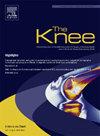Dynamic variation of tibiofemoral compression force during total knee arthroplasty: Implications for soft tissue balance and functional outcomes
IF 1.6
4区 医学
Q3 ORTHOPEDICS
引用次数: 0
Abstract
Background
Achieving precise alignment and soft tissue balance is crucial for optimal total knee arthroplasty (TKA) outcomes. We aimed to explore how tibiofemoral compression force (TFCF) varies with knee flexion and its correlation with functional outcomes.
Methods
This prospective study included 60 patients undergoing cruciate-retaining TKA (FINE Total Knee System). Sensor-equipped trial inserts were used to measure the TFCF at 15° intervals, from full extension to 90° flexion. Patients were classified into anterior and posterior force groups based on whether the medial TFCF was higher in the anterior than in the posterior region at 60° flexion. The 2-year outcomes were assessed using the Knee Injury and Osteoarthritis Outcome Score Joint Replacement (KOOS-JR).
Results
The total TFCF increased from 0° to 60° flexion and then decreased. The medial compressive forces were consistently higher than lateral forces. Anteromedial TFCF differed significantly between the anterior and posterior force groups at 60°, 75°, and 90° flexion. KOOS-JR scores showed a significant interaction between force type and time, with greater improvements in the anterior force group. Anteromedial TFCF at 60° flexion and KOOS-JR correlated significantly (R = 0.574).
Conclusion
Evaluating TFCF at multiple knee flexion angles provides valuable insights into optimising outcomes in TKA. TFCF variations, especially in the anteromedial compartment, considerably impact functional outcomes. Dynamic TFCF measurements during TKA may enhance soft tissue balance and improve outcomes. Further research is needed to validate these findings in diverse populations and with long-term follow ups.
全膝关节置换术中胫骨股压力的动态变化:对软组织平衡和功能结果的影响。
背景:实现精确对齐和软组织平衡是最佳全膝关节置换术(TKA)结果的关键。我们的目的是探讨膝关节屈曲时胫股压迫力(TFCF)的变化及其与功能预后的关系。方法:本前瞻性研究纳入了60例接受全膝关节系统(FINE Total Knee System)的患者。使用配备传感器的试验插入物以15°间隔测量TFCF,从完全伸展到90°屈曲。根据60°屈曲时内侧TFCF是否在前区高于后区,将患者分为前后力组。使用膝关节损伤和骨关节炎结局评分关节置换术(KOOS-JR)评估2年结果。结果:总TFCF从0°屈曲到60°屈曲先升高后降低。内侧压缩力始终高于侧向力。前内侧TFCF在60°、75°和90°屈曲时前后力组之间差异显著。KOOS-JR评分在用力类型和时间之间表现出显著的交互作用,前用力组改善更大。60°屈曲时前内侧TFCF与KOOS-JR显著相关(R = 0.574)。结论:评估多个膝关节屈曲角度下的TFCF为优化TKA的预后提供了有价值的见解。TFCF的变化,特别是在前内侧室,显著影响功能结局。TKA期间动态TFCF测量可增强软组织平衡,改善预后。需要进一步的研究在不同人群中验证这些发现并进行长期随访。
本文章由计算机程序翻译,如有差异,请以英文原文为准。
求助全文
约1分钟内获得全文
求助全文
来源期刊

Knee
医学-外科
CiteScore
3.80
自引率
5.30%
发文量
171
审稿时长
6 months
期刊介绍:
The Knee is an international journal publishing studies on the clinical treatment and fundamental biomechanical characteristics of this joint. The aim of the journal is to provide a vehicle relevant to surgeons, biomedical engineers, imaging specialists, materials scientists, rehabilitation personnel and all those with an interest in the knee.
The topics covered include, but are not limited to:
• Anatomy, physiology, morphology and biochemistry;
• Biomechanical studies;
• Advances in the development of prosthetic, orthotic and augmentation devices;
• Imaging and diagnostic techniques;
• Pathology;
• Trauma;
• Surgery;
• Rehabilitation.
 求助内容:
求助内容: 应助结果提醒方式:
应助结果提醒方式:


